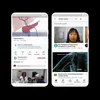Introducing new ways to help you find answers to your health questions
YouTube is here to help you make informed decisions about your health journey
Jul 19, 2021 [[read-time]] minute read

Jul 19, 2021 [[read-time]] minute read
What’s the first thing you do when you have a question about your health? If you’re like most Americans, you head online. Whether you want to learn how to measure your blood sugar after a diabetes diagnosis, understand the different stages of breast cancer, join a community of others who are living with rare conditions or take charge of your heart health, YouTube is here to help you make informed decisions about your health journey.
“YouTube...has the potential to be a transformative tool for public health and can positively impact communities at scale.”
Dr. Garth Graham
At YouTube, we’re working to make it easier for people to find authoritative information to help answer their questions, and we’re putting health professionals at the core of our efforts to connect people with helpful content. I’ve spent my career trying to advance the ways that we can better reach people with the information they need to make the right health choices for themselves and their families, and I’ve had a front row seat as our approaches evolved from pamphlets handed out at doctor’s offices to online patient portals and telemedicine.
In our increasingly digital world, the next phase in health communication is video, where we can connect with people and answer their questions in a way that is both visual and personal. I joined YouTube because I believe that this platform, with 2 billion monthly active users, has the potential to be a transformative tool for public health and can positively impact communities at scale.
Over the last year, we've continued to expand our partnerships with leading health organizations like Mass General Brigham and the American Public Health Association, as well as with clinicians and creators, to further increase the accessibility of high quality health content on our platform. These organizations are creating engaging, evidence-based videos that really connect with people, such as JAMA's crisp explanation of mRNA, Stanford Center for Health Education's Viral Facts Series, the National Alliance on Mental Illness' mental health collaboration with Vogue and many more. We’ve introduced ways to get the latest COVID-19 information and education out and reach billions of people. And now, we’re announcing two new ways that we’ll surface credible and relevant health information for people in the United States.
Starting this week, you’ll see new features next to some health-related searches and videos. We’re adding new health source information panels on videos to help viewers identify videos from authoritative sources, and health content shelves that more effectively highlight videos from these sources when you search for specific health topics. These context cues are aimed at helping people more easily navigate and evaluate credible health information. People will still be able to find relevant videos from a range of sources in their search results.
To identify the right sources to include in these new features, we applied the principles developed by an expert panel convened by the National Academy of Medicine, a nonprofit, nongovernmental organization that brings together the top experts in health, medicine, and biomedical science to provide unbiased, evidence-based guidance about health and science. The National Academy of Medicine regularly examines complicated questions related to health, medicine, and biomedical science and over the years they have given guidance on everything from countering the opioid epidemic to gene editing.
Back in February, YouTube asked an expert panel convened by the National Academy of Medicine to consider the question of how to define “authoritative health content sources” and the ways in which those sources attain and maintain their authority. The expert panel drafted these principles for health sources, which are the first of their kind. We hope that other tech companies will also review and consider how these principles might help inform their work with their own products and platforms.
This is our first step towards identifying and designating authoritative health sources on YouTube. While only accredited health organizations and government entities are currently included in our health context features, we’re exploring ways to broaden eligibility and evaluate inclusion of other health sources, as well as ways to expand these features globally.
Throughout my years of working in public health and practicing medicine, I have seen the benefits of getting the right information to patients when they need it. These new features are an important step to improve our platform’s role in connecting people with high quality information. We know that there is more work to be done and our investment will continue for the long-term.